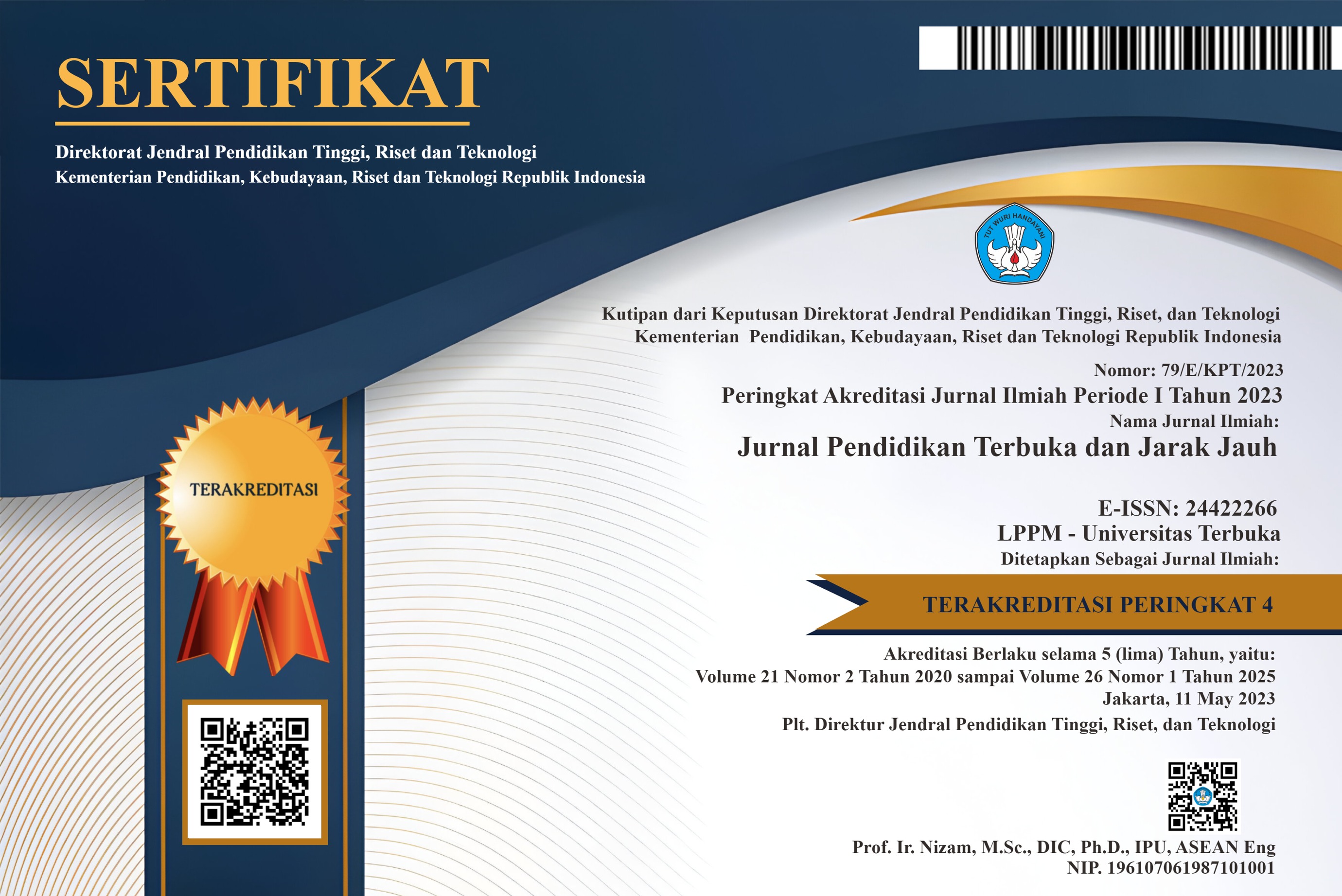TINGKAT KEPEDULIAN DAN SELF EFFICACY MAHASISWA UNIVERSITAS TERBUKA TERHADAP E-LEARNING
Keywords:
level of apprehension to e-learning, online tutorial, self efficacy to e-learningAbstract
Research on the level of apprehension and self efficacy of Universitas Terbuka’s students to E-learning was aimed at investigating the level of apprehension and self efficacy to e-learning as well as to prove the reasearch hypothesis that the apprehension stages has a significant corellation to the level of self efficacy in using e-leaning. The population of the study was Universitas Terbuka’s students registered to courses that offer online tutorials. The sample was choosen by a purposive random sampling technique from students from 4 faculties and magister program taken courses offered by online tutorial and registered by the most of the students. The result of the research gave a general picture of students’ self efficacy in using the Internet make use of e-learning in their study activities was considering in average category. The average score of students’ capability of using Internet was 3.73 from 6 Likert scale. The highest score of students’ capability in using the Internet was their ability in reading text. On the other hand, capability that considered low was students’s capability in creating a simple web page using teks, pictures, and links. The students’ awareness in using e-learning for their learning activities was varied. Based on 54.76% students who were using e-learing , 2.38% were in management stage, 21.43% at consequence stage, 9.52% in collaboration stage, and 21,43% in refocusing stage. The findings suggest a positive correlation between the students’ self-efficacy level in using Internet with their awareness in using e-learning.
References
Bandura, A. (1993). Perceived self-efficacy in cognitive development and functioning. American Psychologist, 28(2), 117 – 148.
Bandura A. (1994). Self-efficacy. In V.S. Ramachaudran (Ed.), Encyclopedia of human behavior (Vol. 4), 71 – 81. New York: Academic Press.
Bandura, A. (1989). Human agency in social cognitive theory. American Psychologist, 44(9), 1175 – 1184.
Blocher, J.M., De Montes, L. S., Willis, E. M., & Tucker, G. (2002). Online learning: Examining the successfull students profile. Journal of Interactive Online Learning, 1(2).
Borg, W.R. & Gall, M.D. (1989). Educational research: An introduction (5th ed.). White Plains, N.Y.: Longman.
Errington, E.P. (2001). The influence of teacher beliefs on flexible learning innovation in traditional university setting. Dalam Innovation in open and distance learning.
Howell, D.C. (1989). Fundamental statistics for behavioural sciences (2nd ed.). Boston: PWS-KENT.
Miller, M.D., Rainer, R.K., & Corley, J.K. (2003). Predictors of engagement and participation in an on-line course. Online Journal of Distance Learning Administration, VI (1).
Mungaria (2003). The seven e-learning barriers focusing employees. elearning@aerckenya.org.
Rakes, C.G. & Casey, H.B. (2002). An analysis of teacher concerns toward instructional technology. International Journal of Educational Technology. Dalam ijet@ncsa.uiuc.edu.
Schaafsma, H. & Athanasou, J. (1994). Measuring the implementation of quality innovation in the workplace. AARE Annual Conference, University of Newcastle.
Schunk, D.H. (1991a). Self-efficacy and academic motivation. Educational Psychologist, 26(3 & 4), 207- 231.
Schunk, D.H. (1991b). Learning theories: An educational perspectives. New York, N.Y.: Macmillan.
Soekartawi (2004). Mengapa diperlukan pendidikan tinggi jarak jauh. Dalam Asandhimitra, dkk. (Ed.), Pendidikan tinggi jarak jauh, hal. 3 - 25. Jakarta: Pusata Penerbitan UT.
Soekartawi, Haryono, A., & Librero, F. (2002). Greater learning opportunities through distance education: Experiences in Indonesia and the Philippines. Journal of Southeast Asian Education, 3 (2).
Weller, M. (2002). Delivering learning on the net. The why, what, & how of online education. London: UK: Kogan Page.





